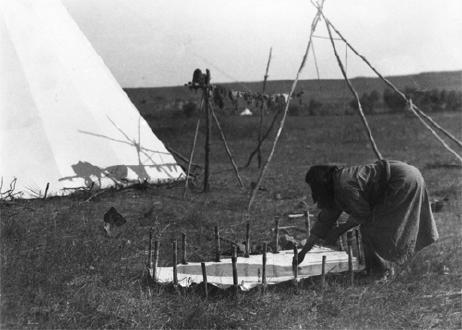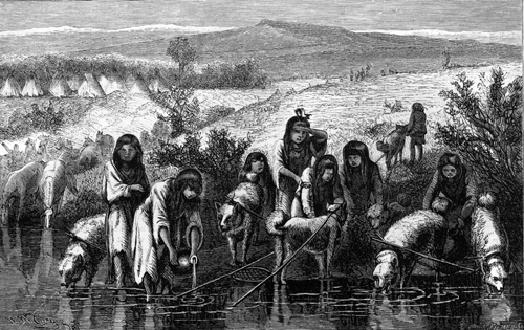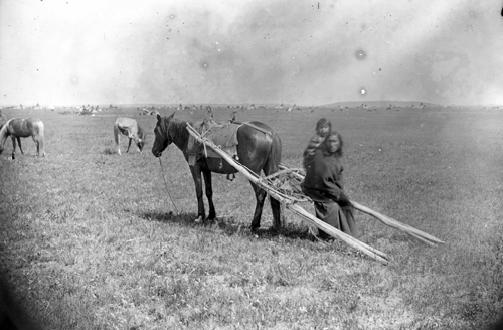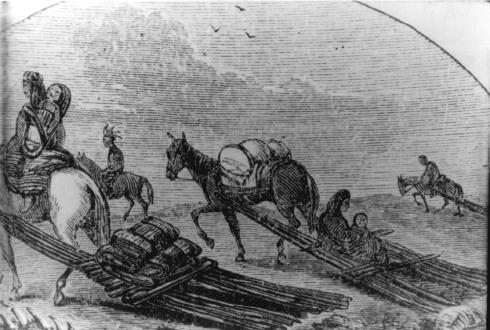Women's Work
What do these photos tell you about the kind of work Indian women did?
Scraping A Hide
The Indian woman in this photo is scraping an animal hide. The hide is stretched and held in place by wooden stakes. She is using a metal tool as a scraper.

Photo: Denver Public Library, Western History Collection
More About This Topic
Women scraped hides to remove bits of fat and flesh left on the hide. If these were not removed, the hide would spoil. Scraping also made buffalo hides thinner and lighter. After scraping, the hide was tanned. A tanning mixture made of brains, liver, soapweed, and grease was rubbed into the hide. Tanning made it soft.
Their Own Words
"Then women had had a great deal to do when buffalo were killed. As soon as they had skinned the animal, they spread the skin on the ground and pegged it down to stretch and dry. They dressed it with bone and horn tools, to take off all the flesh and to soften it. The women spent many hours down on their hands and knees working on a hide, but when at last it was fleshed and softened and dried it made the finest and warmest kind of robe."
Source: Althea Bass, The Arapaho Way: A Memoir of an Indian Boyhood [by Carl Sweezy] (New York: Clarkson N. Potter, Inc., 1966), p. 28-29.
Various Tools
The tools in the photo include a scraper (bottom), an awl (middle) and an awl case (top). The steel blade in this scraper has an elk-horn handle. The blade is fastened to the handle with strips of leather. The awl is a bone sharpened at one end.

Photo: Colorado Historical Society
More About This Topic
Indian women had many specialized tools. They used scrapers to scrape hides. Awls were used to punch holes in leather. Women also used flint, and later steel, knives; spoons made of bone; and bone needles for sewing.
Drawing Water
The women in this drawing are collecting water. They are loading the water jugs on travois pulled by dogs. The dogs will carry the water back to camp. This illustration appeared in 1870 in a magazine called Appleton's Journal.

Photo: Denver Public Library, Western History Collection
More About This Topic
The Indians who lived on the plains usually camped beside a stream so they would have fresh water. Each morning the women went to the stream to bring water back to camp. The Cheyenne did not use water that had stood over night. They called it "dead water." It was better to drink "living water" fresh from a stream.
Their Own Words
"Whenever we camped, they [the women] carried water from the nearest stream or spring, and wood for our fires. Mornings and evenings, it was a pleasant sight to see them going in groups for water, singing and laughing and talking....Often they stopped to bathe in the stream before they came back."
Source: Althea Bass, The Arapaho Way: A Memoir of an Indian Boyhood [by Carl Sweezy] (New York: Clarkson N. Potter, Inc., 1966), p. 27.
Gathering Fire Wood
The women in this photo are carrying wood back to camp. For the Indians of the plains, this chore was often not easy. That was so because there was so few trees on most of the plains. Indians often used buffalo chips for fuel. Gathering buffalo chips was also women's work.

Photo: Denver Public Library, Western History Collection
More About This Topic
Gathering wood for cooking and heating also was a woman's job. They went out in groups to gather sticks lying on the ground or break off dead branches from the trees. They tied these together in bundles and carried them back to camp. A small fire made of twigs would keep a tepee warm at night.
Sitting On A Travois
The woman in this photo is sitting on a travois. The travois was made of long poles with a platform in the middle. A child is standing on the platform behind her.

Photo: Denver Public Library, Western History Collection
More About This Topic
Each family's herd of horses included work horses as well as horses used for hunting and for war. These horses often belonged to the women. They used them to pull the travois when it was time move camp.
Their Own Words
"The Utes were moving camp with 400 ponies, many superb animals. Tent poles, six on either side, were fastened to the ponies of the squaws, one end of each pole dragging on the ground behind. The squaws attend to loading and packing the animals. On the top of many of these packs were perched papooses, strapped securely on, but old enough to drive and guide their ponies."
Source: An account from 1873 in Jan Pettit, Utes: The Mountain People (Boulder: Johnson Books, 1990), p. 21.
Moving Camp
This drawing shows Indians using travois to move camp. The travois on the left is loaded with bundles. The one in the middle is carrying a woman and a child.

Photo: Colorado Historical Society
More About This Topic
When camp was moved, the boys drove the horses into camp. The women took down the tepees, tied 5 or 6 of the poles to each horse, and laid hide over the poles behind the horse to fastened them together. This made a platform on which the women could place bundles. They bundled up all their belongings and placed them on the platform between the poles. The women drove the horses to the next camp.
Their Own Words
"The dragging of the poles on the ground made a very road track that was used year after year until the path became a well-worn road. They always followed their forefathers' path, no matter how worn it became. These "Lodge Pole Trails" became wilderness highways followed by explorers, prospectors, and freight wagons. Many of these old Ute trails are the routes of present-day highways."
Source: Jan Pettit, Utes: The Mountain People (Boulder: Johnson Books, 1990), p. 22.

